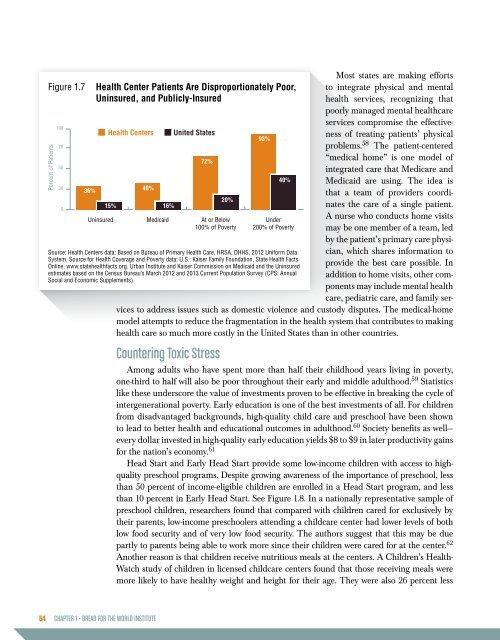THE NOURISHING EFFECT
HR2016-Full-Report-Web
HR2016-Full-Report-Web
Create successful ePaper yourself
Turn your PDF publications into a flip-book with our unique Google optimized e-Paper software.
Figure 1.7<br />
Percent of Patients<br />
100<br />
75<br />
50<br />
30<br />
0<br />
36%<br />
Health Center Patients Are Disproportionately Poor,<br />
Uninsured, and Publicly-Insured<br />
Health Centers<br />
40%<br />
15% 16%<br />
United States<br />
Uninsured Medicaid At or Below<br />
100% of Poverty<br />
Under<br />
200% of Poverty<br />
Source: Health Centers data: Based on Bureau of Primary Health Care, HRSA, DHHS, 2012 Uniform Data<br />
System. Source for Health Coverage and Poverty data: U.S.: Kaiser Family Foundation, State Health Facts<br />
Online, www.statehealthfacts.org. Urban Institute and Kaiser Commission on Medicaid and the Uninsured<br />
estimates based on the Census Bureau’s March 2012 and 2013 Current Population Survey (CPS: Annual<br />
Social and Economic Supplements).<br />
72%<br />
20%<br />
93%<br />
40%<br />
Most states are making efforts<br />
to integrate physical and mental<br />
health services, recognizing that<br />
poorly managed mental healthcare<br />
services compromise the effectiveness<br />
of treating patients’ physical<br />
problems. 58 The patient-centered<br />
“medical home” is one model of<br />
integrated care that Medicare and<br />
Medicaid are using. The idea is<br />
that a team of providers coordinates<br />
the care of a single patient.<br />
A nurse who conducts home visits<br />
may be one member of a team, led<br />
by the patient’s primary care physician,<br />
which shares information to<br />
provide the best care possible. In<br />
addition to home visits, other components<br />
may include mental health<br />
care, pediatric care, and family services<br />
to address issues such as domestic violence and custody disputes. The medical-home<br />
model attempts to reduce the fragmentation in the health system that contributes to making<br />
health care so much more costly in the United States than in other countries.<br />
Countering Toxic Stress<br />
Among adults who have spent more than half their childhood years living in poverty,<br />
one-third to half will also be poor throughout their early and middle adulthood. 59 Statistics<br />
like these underscore the value of investments proven to be effective in breaking the cycle of<br />
intergenerational poverty. Early education is one of the best investments of all. For children<br />
from disadvantaged backgrounds, high-quality child care and preschool have been shown<br />
to lead to better health and educational outcomes in adulthood. 60 Society benefits as well—<br />
every dollar invested in high-quality early education yields $8 to $9 in later productivity gains<br />
for the nation’s economy. 61<br />
Head Start and Early Head Start provide some low-income children with access to highquality<br />
preschool programs. Despite growing awareness of the importance of preschool, less<br />
than 50 percent of income-eligible children are enrolled in a Head Start program, and less<br />
than 10 percent in Early Head Start. See Figure 1.8. In a nationally representative sample of<br />
preschool children, researchers found that compared with children cared for exclusively by<br />
their parents, low-income preschoolers attending a childcare center had lower levels of both<br />
low food security and of very low food security. The authors suggest that this may be due<br />
partly to parents being able to work more since their children were cared for at the center. 62<br />
Another reason is that children receive nutritious meals at the centers. A Children’s Health-<br />
Watch study of children in licensed childcare centers found that those receiving meals were<br />
more likely to have healthy weight and height for their age. They were also 26 percent less<br />
54 CHAPTER 1 • BREAD FOR <strong>THE</strong> WORLD INSTITUTE


